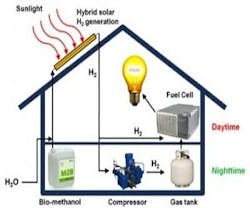Duke Engineer Builds Hybrid Solar Power System
While roofs across the world sport photovoltaic solar panels to convert sunlight into electricity, a Duke University engineer believes a novel hybrid system can wring even more useful energy out of the sun's rays.
Instead of systems based on standard solar panels, Duke engineer Nico Hotz proposes a hybrid option in which sunlight heats a combination of water and methanol in a maze of glass tubes on a rooftop. The system produces hydrogen much more efficiently than current technology without significant impurities. The resulting hydrogen can be stored and used on demand in fuel cells.
For his analysis, Hotz compared the hybrid system to three different technologies in terms of their exergetic performance. Exergy is a way of describing how much of a given quantity of energy can theoretically be converted to useful work.
"The hybrid system achieved exergetic efficiencies of 28.5 percent in the summer and 18.5 percent in the winter, compared to 5 to 15 percent for the conventional systems in the summer, and 2.5 to 5 percent in the winter," says Hotz, assistant professor of mechanical engineering and materials science at Duke's Pratt School of Engineering.
Like other solar-based systems, the hybrid system begins with the collection of sunlight. Then things get different. While the hybrid device might look like a traditional solar collector from the distance, it is actually a series of copper tubes coated with a thin layer of aluminum and aluminum oxide and partly filled with catalytic nanoparticles
"This set-up allows up to 95 percent of the sunlight to be absorbed with very little being lost as heat to the surroundings," says Hotz. "This is crucial because it permits us to achieve temperatures of well over 200 degrees Celsius within the tubes. By comparison, a standard solar collector can only heat water between 60 and 70 degrees Celsius."
Once the evaporated liquid achieves these higher temperatures, tiny amounts of a catalyst are added, which produces hydrogen. This combination of high temperature and added catalysts produces hydrogen very efficiently, Hotz said. The resulting hydrogen can then be immediately directed to a fuel cell to provide electricity to a building during the day, or compressed and stored in a tank to provide power later.
The hydrogen system is also more cost effective than other models
"We performed a cost analysis and found that the hybrid solar-methanol is the least expensive solution, considering the total installation costs of $7,900 if designed to fulfill the requirements in summer, although this is still much more expensive than a conventional fossil fuel-fed generator," Hotz says.
The paper describing the results of Hotz's analysis was named the top paper during the ASME Energy Sustainability Fuel Cell 2011 conference in Washington, D.C.
